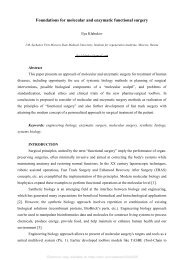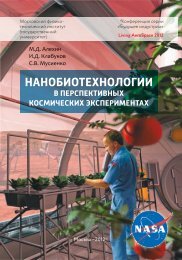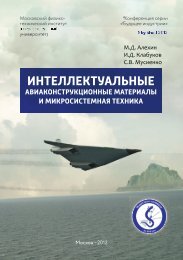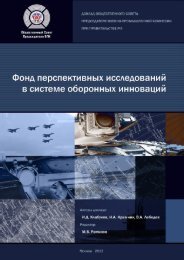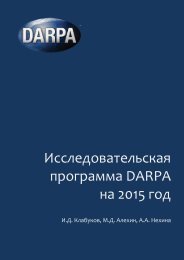Engineering Biology Problems Book (2021, Obninsk Edition)
Create successful ePaper yourself
Turn your PDF publications into a flip-book with our unique Google optimized e-Paper software.
[67. Bates, F. (2014). Nanomedicine: A Hyper-expectation and Dawning Realisation?. In
Nanomedicine (pp. 271-304). Springer, New York, NY.].
2.53 Neurorehabilitation. Following a traumatic brain injury accompanied by large-scale
hemorrhage and ischemia, patients are often in a state of "low consciousness" characterized by
reduced brain function, abnormalities in the neuroregulation of internal organs, etc. These conditions
can be rehabilitated, but often remain for life. Propose a way to induce plastic growth of axons to
prevent the development of post-traumatic disorders and neurorehabilitation.
SOLUTION:
There is currently no solution to this problem. However, the reader can try to find an acceptable
solution.
2.54 Self-making. Many of the structural imperfections and “design flaws” of the human body are
related to what anthropologist Neil Shubin refers to as the "inner fish" [68]. The “inner fish” is a
concept that explains our imperfection by the fact that human beings did not emerge as a finished
project designed for sedentary work and corporate events but as one of the links in a continuous
evolutionary chain in which fish came to land and conquered a new habitat. What features of the
human body can be explained by this concept?
SOLUTION:
In addition to what was stated in Problem 2.1. "Blade Runner", the following can be noted (text
provided by [69], Figure 2.4 by [70]):
1. The gastrointestinal tract of mammals overlaps with the respiratory tract, as a result of which, it’s
impossible to breathe and swallow at the same time. Moreover, this also creates a risk of choking and
is the reason behind the occurrence of nighttime apnea. The evolutionary explanation behind these
problems is that the ancestors of mammals were a species of keystone fish that swallowed air to
breathe.
2. A thoracic aortic aneurysm and a giant left atrium (in the advanced stages of mitral insufficiency)
may be the cause of hoarseness of the voice. This is due to compression of the recurrent laryngeal
nerve, which goes into the thorax as part of the vagus nerve and then returns to the larynx. The
recurrent nerve, for example, in the giraffe is up to 4 meters long. As we know from personal
experience, the more complex a device is, the more often it breaks. So why create such a long
structure? After all, the distance from the nerve exit point to the larynx itself is no more than four
centimeters! The fact of the matter is that the organs, which are innervated by the vagus nerve were all
formed from the 6th gill arch of fish, and, in the process of evolution, became separated by a
considerable distance. And, as we all know, fish don't have necks.
3. The main cause of reduced cardiac output, and hence blood delivery to organs (e.g. kidneys) in
human ancestors was an injury accompanied by blood loss. The kidneys reacted by retaining salts and
fluids to replenish the circulating blood volume. Nowadays the main cause of reduced cardiac output
is not blood loss, but rather myocardial infarction. When a piece of the heart muscle dies off, the heart
no longer properly performs its pumping function. Decreased cardiac output, just like millions of
years ago, leads to compensatory fluid retention in the body. Fluid is retained in the large and small
circulatory systems. Swelling of the lungs, liver, and legs occurs. The signs of heart failure appear.
Therefore, diuretics are the main way to combat heart failure.
4. One of the hypotheses explaining obesity formed by anthropologist James Neill was the concept of
the 'frugal genotype'. Its essence was that the ancestors of modern humans, as hunters and gatherers,
lived in alternating periods of abundance and famine. In periods of plenty, humans stored food in the
form of fat deposits, so that later, in times of famine, they survive off of them until the next successful
hunt. This mechanism works perfectly fine for boom and bust cycles but fails miserably when
high-calorie food is available all day and all year round in supermarkets. Cardiovascular disease and
type 2 diabetes as a consequence of obesity are also consequences of this evolutionary mechanism.
5. During physical activity, a large number of capillaries in the muscles open, and the surface area of
the endothelium (the cells of the inner membrane of the vessels) that is washed by the blood increases
hundreds of times. It is at the boundary of blood and endothelium where shear stress occurs during
physical activity and leads to the production of divalent nitrogen (NO) and other biologically active
and beneficial substances. NO expands blood vessels, lowers blood pressure, improves blood





